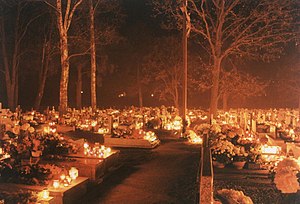Halloween is one of the oldest holidays with origins going back thousands of years. The holiday we know as Halloween has had many influences from many cultures over the centuries. From the Roman's Pomona Day, to the Celtic festival of Samhain, to the Christian holidays of All Saints and All Souls Days. Hundreds of years ago in what is now Great Britain and Northern France, lived the Celts. The Celts worshipped nature and had many gods, with the sun god as their favorite. It was the Sun God who commanded their work and their rest times, and who made the earth beautiful and the crops grow. The Celts celebrated their New Year on November 1st. It was celebrated every year with a festival and marked the end of the "season of the sun" and the beginning of "the season of darkness and cold." The Celts believed, that during the winter, the sun god was taken prisoner by Samhain, the Lord of the Dead and Prince of Darkness.
On the eve before their new year (October 31), it was believed that Samhain called together all the dead people. The dead would take different forms, with the bad spirits taking the form of animals. The most evil taking the form of cats.
On October 31st after the crops were all harvested and stored for the long winter the cooking fires in the homes would be
extinguished. The Druids, the Celtic priests, would meet in the hilltop in the dark oak forest (oak trees were considered sacred). The Druids would light new fires and offer sacrifices of crops and animals. As they danced around the the fires, the season of the sun passed and the season of darkness would begin.
When the morning arrived the Druids would give an ember from their fires to each family who would then take them home to start new cooking fires. These fires would keep the homes warm and free from evil spirits. The November 1st festival was named after Samhain and honored both the sun god and Samhain. The festival would last for 3 days. Many people would parade in costumes made from the skins and heads of their animals. This festival would become the first Halloween.
During the first century the Romans invaded Britain. They brought with them many of their festivals and customs. One of these was the festival know as Pomona Day, named for their goddess of fruits and gardens. It was also celebrated around the 1st of November. After hundreds of years of Roman rule the customs of the Celtic's Samhain festival and the Roman Pomona Day
mixed becoming 1 major fall holiday.
The next influence came with the spread of the new Christian religion throughout Europe and Britain. In the year 835 AD the Roman Catholic Church would make November 1st a church holiday to honor all the saints. This day was called All Saint's Day, or Hallowmas, or All Hallows. Years later the Church would make November 2nd a holy day. It was called All Souls
Day and was to honor the dead. It was celebrated with big bonfires, parades, and people dressing up as saints, angels and devils.
But the spread of Christianity did not make people forget their early customs. On the eve of All Hallows, Oct. 31, people continued to celebrate the festival of Samhain and Pomona Day. Over the years the customs from all these holidays mixed. October 31st became known as All Hallow Even, eventually All Hallow's Eve, Hallowe'en, and then - Halloween.
The Halloween we celebrate today includes all of these influences, Pomona Day's apples, nuts, and harvest, the Festival of Sanhain's black cats, magic, evil spirits and death, and the ghosts, skeletons and skulls from All Saint's Day and All Soul's Day.
Legends and History of Halloween
History and Meanings of Days of the Dead ( Dias de los Muertos)

